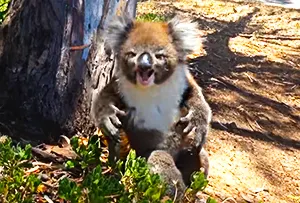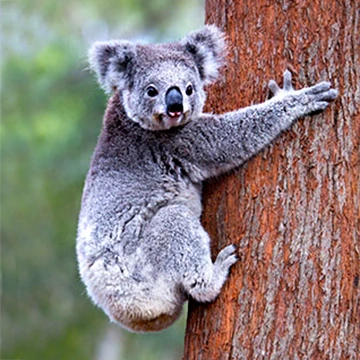
Contents
What is A Koala?
With its fluffy ears, big black nose, and round, cuddly body, the koala resembles a living teddy bear. However, despite being called the "Koala Bear," this fascinating creature is not a bear at all—it is a marsupial, meaning it carries and raises its young in a pouch. Native to Australia, koalas spend most of their lives in eucalyptus trees, munching on leaves and sleeping up to 20 hours a day. Learn all about these adorable animals below!
The word koala is pronounced "co-aa-laa".
Is a Koala a Bear?
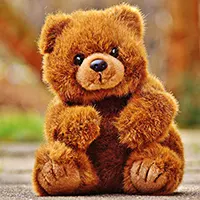
Despite their teddy-bear-like appearance, koalas are not bears. They are marsupial mammals, meaning they give birth to underdeveloped young that continue to grow in their mother’s external pouch. True bears, on the other hand, are placental mammals and have a completely different evolutionary history. The confusion began when early European settlers first saw koalas and mistakenly thought they were bears and called them “Koala Bears.” While the name stuck, it remains scientifically incorrect.
Koala Description & Unique Features
• Koalas are 70–90 cm (27-35 in) in length and weigh 4–15 kg (9-33lbs).
• Their faces are cute with small forward-facing eyes, big noses, and large oval-shaped furry ears for acute hearing.
• The koala doesn't have a visible external tail. This is a result of its sitting behaviour.
• Their fur colour ranges from grey to brown, with the fur on their chests usually being white or yellowish-grey.
• Male koalas also have a moist, dark, hairless patch on the middle of their chests with a scent-producing gland. They rub this scent on tree trunks to mark their territories.
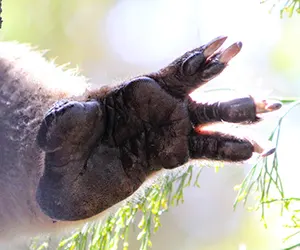
Photo: Koala's foot with big toe and fused toes
• Koala have long, powerful arms and legs with clawed hands and feet with rough padded palms and soles suitable for climbing.
• Koalas have two opposable thumbs on each hand and three fingers to better grasp tree trunks and branches.
• Koalas have unique fingerprints—just like humans!
• The koala has rough padded feet with five toes. Its big toes are opposable, broad and do not have a claw. The second and third toes are fused together but have two separate toenails. The koala also uses the toenails of the joined toes as a convenient comb to groom itself with.
• It has thick cartilaginous padding hidden beneath the fur of its posterior (bottom) that acts as comfortable cushion while resting or sleeping.
• As a result of its sitting behaviour, the koala doesn't have a visible external tail.
• The koala sleeps 18-20 hours a day to conserve energy.
• Koalas vary in size and fur colour depending on where they live in Australia. Those found in the warmer climates of Queensland and northern New South Wales are lighter in colour and significantly smaller than those found to the south in Victoria, where the weather is much colder.
Why Do Koalas Have Such Small Brains?
At first glance, the koala’s large head might suggest a substantial brain, but in reality, its brain is surprisingly small and simple. In fact, it makes up just 0.2% of the koala’s body weight and occupies only 61% of its brain cavity—far less than most mammals of similar size. This limited brainpower explains some of the koala’s peculiar behaviours.
For example, if you place fresh eucalyptus leaves in a bowl, a koala won’t recognize them as food, even though it eagerly munches on the same leaves when they’re still attached to a tree. Similarly, koalas don’t seem to grasp the concept of rain and will sit in downpours, seemingly unaware of why they’re getting soaked!
Where Do Koalas Live?
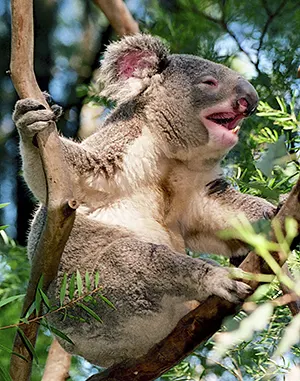
Photo: Koala bellowing in a tree
Koalas are found along Australia’s eastern and southern coastlines, in eucalyptus forests and woodlands. They are arboreal, prefer to live alone and rarely come down to the ground except to travel from one tree to another. Each koala has a home range, a specific area it claims as its territory, and rarely ventures far from it.
Within its home range, a koala will mark its favourite feeding trees and will vigorously defend these home trees aggressively. While home ranges may overlap, a koala will not venture onto the home trees of another koala (see video).
What do Koalas Eat?
Koalas are fussy eaters! Their diet consists almost entirely of eucalyptus leaves, but they only consume about 35 out of the 600+ eucalyptus species. These leaves are toxic to most animals, but koalas have evolved a specialized digestive system, including an extended cecum filled with bacteria to break down the toxins. The koala feeds mainly at night, consuming approximately 400gm (14oz) of leaves daily. They don’t drink much water—most of their hydration comes from their food. The koala gets very little energy from its food. So it sleep most of the day to conserve energy.
The koala poops all day long, even while sleeping. It produces up to 360 dark green olive-shaped faecal pellets with a strong eucalyptus smell.
For more information, here is an excellent scientific paper on the koala's diet.
What Does a Koala Sound Like?
Despite their cute and quiet appearance, koalas produce a deep, bellowing grunt, especially during the breeding season. Males bellow to attract females and establish dominance, while both sexes may squeak, scream, or snarl when distressed. A frightened koala may even cry like a baby!
Koala Climbing, Walking & Running
Because of their energy-conserving habits, koalas usually move slowly. But when climbing a tree up from the ground, they will bound with their arms reaching out to grab the trunk while their legs push off behind. This momentary energy-intensive frog leap enables the koala to gain elevation and safety quickly. While in the tree, koalas move along slowly using all four limbs. When they climb down a tree, they back down cautiously and move one limb at a time while gripping on with all three other paws. On the ground, the koala’s gait is slow and awkward. But if scared or alarmed, they can gallop at up to 30kph (18 mph) towards the nearest tree for safety!
Koala Reproduction & Life Cycle
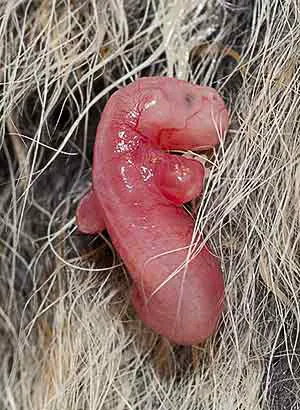
Photo: Newborn joey finding its way to pouch
Koalas give birth to tiny, jellybean-sized joeys after a 35-day pregnancy. At birth, the baby joey is about the size of a jellybean, blind, and has no ears, with tiny stumpy limbs. Once it has exited the mother's birth canal, the joey uses its sense of smell and strong arms to crawl up to its mother's abdomen and into the safety of her pouch, where it latches onto a nipple for nourishment.
At about six months, the joe starts feeding on a runny jelly-like substance, called pap, passed through the mother’s rectum. This pap contains essential gut flora micro-organisms that the joey will need to transition from weaning to leaf-eating. By 12 months, the joey is fully weaned and ready to explore the treetops on its own.
Are Koalas Endangered?
While koalas have native predators such as dingoes, goannas, and large predatory birds, they face their biggest threat from humans. In February 2022, the Australian government declared that the koala was endangered. It is estimated that less than 100,000 koalas are left in the wild. Some estimates put their number as low as 43,000 animals. Listed below are some key contributors to the decline in koala numbers.
Habitat Loss
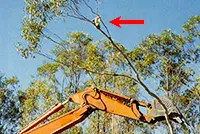
Habitat lose is the major reason for the koala being endangered. The koala population has declined drastically due to the destruction, fragmentation, and loss of their forest habitats. Nearly 80% of the koala's habitat has already disappeared. Most of this deforestation has resulted from human activity such as logging, farming, and suburban sprawl. (Photo: See a frightened koala callously dislodged from a tree).
Motor Vehicles & Dog Attacks
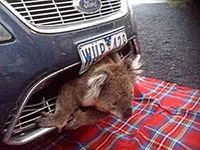
Motor vehicle strikes and dog attacks account for as many as 4,000 koala fatalities yearly While safe in their trees, koalas are vulnerable when they are on the ground walking from one feeding tree to another.
(Photo: This lucky koala had an 80kph impact with a car and survived unscathed).
Bush Fires
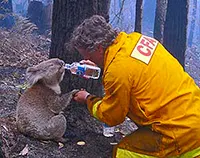
Forest fires in Australia are fast and burn intensely. The koala is too slow to run away from these fires and usually seeks shelter by climbing to the top of a tree. Many perish in bushfires. Sam the Koala (photo) captivated the hearts of millions of people when a fire-fighter rescued her after the Black Saturday bushfires in 2009. Unfortunately, Sam was euthanized later that year because she was suffering from incurable cysts caused by the disease Chlamydia.
Disease
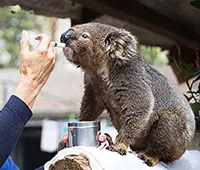
Chlamydia is common in koalas and is a serious threat to the koala population. Chlamydia cause Conjunctivitis which may result in blindness, urinary and reproductive tract infections (which lead to infertility) and pneumonia.
How the Koala Nearly Became Extinct
By the mid-19th century, as European settlements expanded, a booming trade in koala skins emerged. Hunters shot, poisoned, or snared koalas, then bludgeoned them to death for their prized waterproof fur, exported to the US, Canada, and Europe for hats, gloves, and coat linings.
The scale of slaughter was staggering—600,000 koala skins were sold in New South Wales in 1902 alone, and by 1924, nearly 2 million had been exported. By the late 1920s, koalas were on the brink of extinction, wiped out in South Australia and reduced to mere thousands in other states.
Public outrage finally led to a nationwide hunting ban in 1927, but the damage was done. Though koalas were spared from total extinction, their numbers have never fully recovered.
How did the Koala Get its Name?
The word 'koala' is pronounced "co-aa-laa". It is derived from the word gula from the Dharug language of the Yuin-Kuric aboriginal people. The koala's scientific name, phascolarctos cinereus, loosely translates to "ash grey pouched bear". There is no collective noun for a group of koalas. Some names in common usage are 'koala colonies' or 'koala populations'. A very creative person suggested that we should call them a "cling" of koalas.
Interesting Koala Facts
- Koalas live in eucalyptus trees on the eastern seaboard of Australia.
- Koalas in warmer climates are small and lighter than those in colder climates.
- The koala has a padded bottom because it sits so much.
- Because the koala sits so much , it doesn't have a tail.
- The koala has only 11 pairs of ribs. Most most mammals have 13.
- They have unique fingerprints, like humans.
- Koalas sleep 18-22 hours a day.
- To conserve energy, a koala moves slowly and feeds mainly at night.
- It is sometimes called a Koala Bear. But it is not a bear at all. It is a marsupial.
- A male koala is called a boomer. A female koala is called a doe. A baby koala is called a joey.
- The koala's brain has shrunk over evolutionary time.
- The koala prefers to live by itself.
- The koala eats eucalyptus leaves.
- But it only eats the leaves of 35 out of over 600 types of eucalyptus trees.
- This is because most types of eucalyptus are highly toxic.
- The koala uses its highly sensitive nose to sniff out the least poisonous leaves.
- The koala's poo) looks like a dark green olives and smells like eucalyptus.
- The koala gets the moisture it needs from its food and rarely drinks water.
- Koalas weigh 5-12 kilos. The female koala is about 50% smaller than the male.
- The female gives birth to a single baby koala, called a 'joey'.
- The joey is only the size of a human thumbnail when it is born.
- It looks like a pinkish jelly bean with tiny stumpy limbs, which it uses to crawl into its mother's pouch.
- Koalas were almost hunted to extinction.
- Their soft waterproof fur was used to make hats, gloves and linings for coats.
- Kolas live for 10-15 years.
All Rights Reserved. (Last Updated: Apr 19, 2025)
